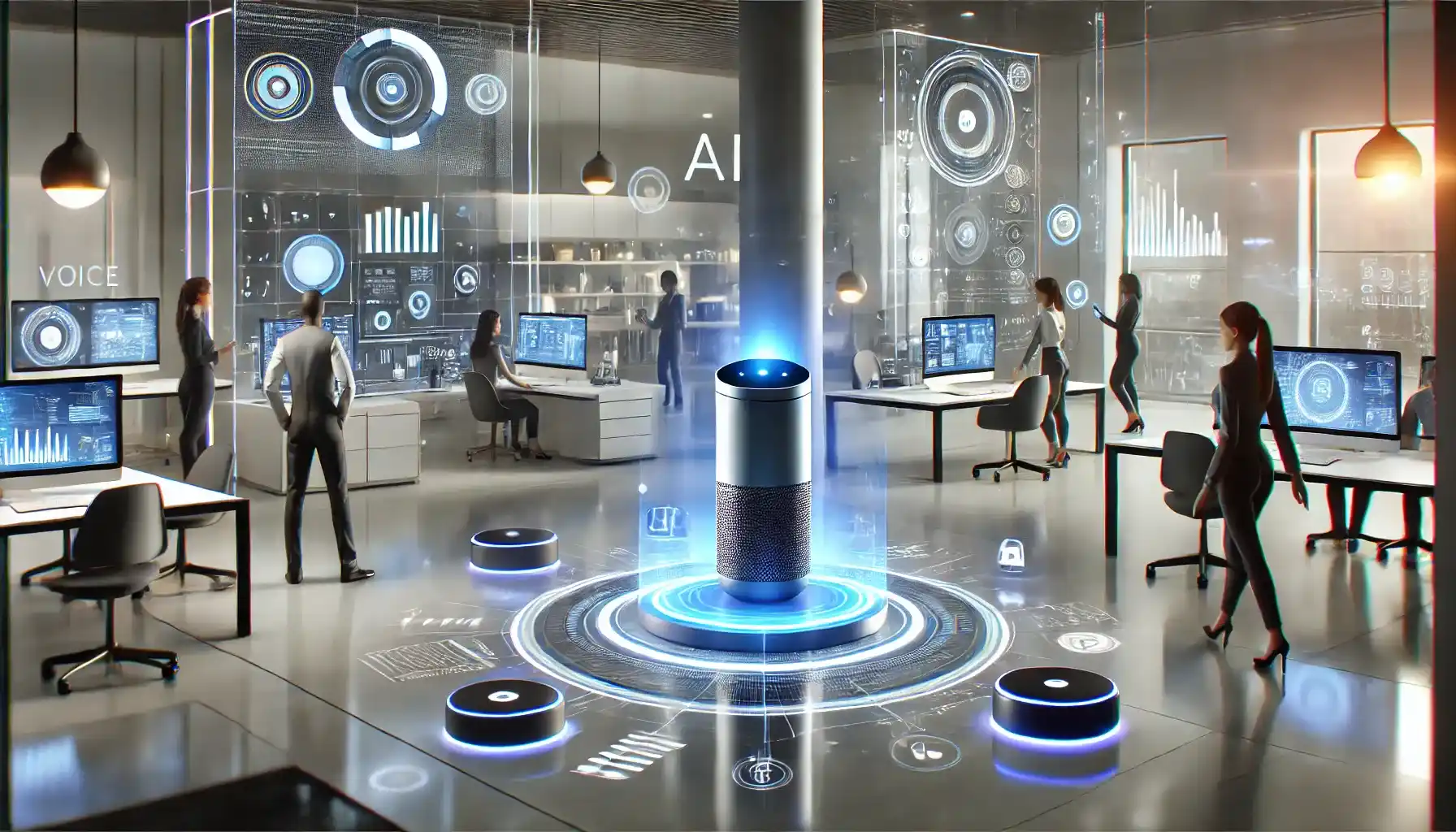Table of Contents
The contemporary digital environment continues to evolve at a remarkable rate, advancing convenience, efficiency, and innovation. Various voice-assisted technologies are among the most revolutionary breakthroughs ushered within the recent past. What started off as a niche solution-a novelty or luxury-has penetrated almost every domain of contemporary life. From smart homes to customer service chat-bots, voice recognition is revolutionising the interaction between users and their devices.
To many IT organisations, the incorporation of voice-enabled technologies is not a fleeting trend; it indeed is part and parcel of future business. This article illustrates principles of how IT firms benefit from this innovation to become more productive, issue better experiences, and become the forefront movers of tech.
The Voice-Activated Revolution: A Game Changer for IT Companies
Voice-activated technology is no longer just a playful tool for casual users. For IT companies, it has turned into the holy grail of voice innovation. Hands-free operation of systems, devices, and software enables employees to work massively well and fast. How companies run offline operations in the tech space to offer results is changing fundamentally.
For IT support companies, embracing voice-activated tech means adopting a solution that can react to voice requests, hence enhancing workflows and making for an easy experience. This involves the management of projects and devices or getting data, and at the end of the day, voice technology is highly interactive and facilitates a much faster response time, whilst allowing workers to engage in higher-value tasks.

The Business Advantages of Voice-Activated Technology
The benefits derived by integrating voice technology in IT companies are numerous, extending beyond conventional areas of operations.
1. Boosting Productivity and Efficiency
- Voice-activation technology allows an employee to avoid switching between an application and typing commands or interacting with software manually. Simple voice commands can open files, send emails, prepare reports, or even control PM tools. With voice technology, IT companies do away with time wasted on standard operating tasks and enable their teams to devote time to complex and strategic work.
- Rather than moving from one window on a screen to another, a developer or manager can simply ask the voice assistant to “open the latest code repository” or “give a summary about the achievements made with this project.” The immediate access to information expedites the workflow and tremendously boosts efficiency.
2. Enhancing Collaboration and Communication
- Voice activation technology plays an integral role in enabling better communication among various teams, even more so with remote and hybrid work models on the rise. With voice commands included in platforms such as Microsoft Teams, Slack or Zoom, employees are now able to schedule meetings, send messages or share files without scheduling their breaks around the tasks at hand.
- In an IT work environment, communication remains very important among developers, especially for large projects. By using voice commands to automate simple tasks like meeting scheduling and calendar tick-offs, employees can take up responsibilities in no time and improve team collaboration, reducing downtime in the process.
3. Improved Customer Support Experience
- Voice-Activated Technology may create a more engaging, efficient, and personalised experience that is seamless for customers in IT companies offering customer support services. Virtual assistants and AI-powered chat-bots that understand and respond to natural language are becoming mainstays in many customer service departments.
- An IT company can have direct voice communication with a customer with a voice-enabled product to troubleshoot or provide technical support for its problem. Such would not only lessen the time of every client but also make it more realistic for the IT company to address queries, thereby using its resources in a better way.
- Voice technology customer service platforms can also understand context so that there is a user to provide comprehensive and useful responses, and anticipate the next question based on previous dialogues. As such, this takes the whole user experience to a different level which is something loyalty and customer satisfaction may fortunately demand.
4. Streamlined Data Management and Retrieval
- Voice activation makes it easy for employees in the IT companies to retrieve any piece of information or report by speaking to the system. Rather than have to go through software interfaces or databases, a project manager could say, “Get me the newest analytics report,” or “Show me the previous quarter’s data.”
- It is an incredible advantage because, with very few cries to reach out and obtain a meaningful business answer, decisions can be taken faster and greater agility can be achieved. Everything that has to do with data entry on spreadsheets and report generation, would be automated, thus contributing to efficient working conditions.
Voice-Activated Technology in IT Product Development
With the addition of voice-activated technology, software and hardware products have been able to rely on one of the essential drivers of innovation for years. With the rapid evolution of technology, consumers are yearning for interfaces that are easy to understand and easy to use; it is also widely accepted that voice command is one of the most intuitive and natural ways of interacting with technology. From smart home devices to dedicated virtual assistant and productivity applications, IT companies in turn are creating products with voice control.
1. Creating Seamless User Experiences
- Consumers crave control over marketplace products with the help of their voices, as seen by the successes of the Amazon Echo, Google Assistant, and Apple Siri products. IT companies incorporating voice recognition into their software or hardware products have gained a competitive edge in their strategies to benefit from the swift-growing demand for hands-free solutions.
- By making their platforms richer for people with disabilities, companies begin opening an avenue toward inclusivity in the digital ecosystem itself. This comes with added prospects for IT companies, which becomes a reason for expanding their customer market base.
- By leveraging voice-enabled technology, businesses can also make their platforms more accessible to people with disabilities, creating a more inclusive digital environment. In turn, this opens up new markets and opportunities for IT companies to expand their customer base.
2. Voice as a Key Feature in SaaS Solutions
- Software as a service (SaaS) companies can further exploit voice-activated technology to differentiate their solutions. Voice commands can really improve user interactions and simplify workflows for all solutions, from ERP systems to project management tools.
- For instance, in project management software, a user might state that they’d like to set up a task for John to follow up on a client email, or set a reminder for the same team meeting at 3 pm tomorrow. The unnecessary task of clicking through several screens can thus be completely avoided, allowing for a faster and much more user-friendly software experience.

Voice-Activated Security: Enhancing Privacy and Safety
Another vital point in voice-activated technology among IT companies is security. Yes, voice recognition technology is an advantage of freedom but one source of problem is the threat against privacy and data protection.
The IT companies can use voice bio metric to add another layer of security to their systems. The voice authentication makes sure that only the legitimate person accesses data or a system that can be misused, thus keeping them immune to fraud and identity theft. The end point which is encryption of voice data also ensures the security of the conversations and provides comfort to the business at hand and to its clients.
The Challenges and the Future of Voice-Activated Technology
Often, technical companies are required to consider all potential issues regarding problems in voice-based technology. Privacy and data security issues disturb system integration. In many cases, to ensure compatible system connections, ease of integration could be justified by re engineering questionable privacy systems and ensuring that data is completely secure.
Voice recognition systems also only still get better with accuracy. Accents, background noises, and clarity of speech seem to cause problems now and then, especially in global IT companies with a variety of workforce. Further improvements of natural language processing technologies and machine learning technologies are thought to inspire developments in this domain, making voice recognition technology even more effective and reliable later.
Conclusion: The Hands-Free Future of IT Companies
As voice technology grows, IT companies stand to gain massively. From increased productivity and better collaboration to novel product introductions and improved customer service experiences, voice technology has completely changed how IT firms function and interact with their clients.
Voice-enabled solutions will become more predominant in business operations in the coming years. Voice-enabled technology has progressed from an option to a necessity for IT companies wishing to remain leaders in their respective areas of business operations, customer service techniques, and the development of new products. Those who get ahead of the game will not only enjoy a higher rate of productivity and innovation; they will also be prime players in defining this emerging approach to hands-free interaction.
The voice-activated revolution is here to stay, and those IT companies that realise its benefits will certainly thrive in the new age of seamless hands-free technology.
Frequently Asked Questions (FAQs)
- What is voice-activated technology?
Voice-activated technology empowers control over devices, applications, and systems with spoken commands. It leverages AI and natural language processing to interpret and perform these commands efficiently. - How can IT companies benefit from voice-activated technology?
IT companies can improve productivity by streamlining work processes, improving customer engagement through a virtual assistant, and integrating voice commands with current infrastructure for smooth operations. - How secure is voice-activated technology?
Voice technology is becoming highly secure through advancements in bio-metric verification techniques and encryption. It remains critical for IT companies to maintain a secure environment for user data and the overall system, so that individuals cannot access data or manipulate results without authorisation. - Can voice-activated technology improve accessibility?
Certainly. Voice technology makes a lot of digital tools easy for people with physical disabilities and offers an intuitive and hands-free mechanism to interface with a system. - What is the future of voice-activated technology?
The future is a more intelligent AI-based, predictive analysis, multilingual, and integration of IoT-supported systems, forming a truly connected digital experience.